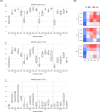Optimization of canine sperm cryopreservation by focusing on glycerol concentration and freezing rate
- PMID: 39841301
- PMCID: PMC11754312
- DOI: 10.1007/s11259-025-10651-w
Optimization of canine sperm cryopreservation by focusing on glycerol concentration and freezing rate
Abstract
The purpose of this study was to improve the quality of frozen-thawed canine spermatozoa through the optimization of glycerol concentration (GC) and freezing rate in the semen freezing protocol. Ejaculates from nine dogs were diluted with an extender containing 0%, 1.5%, 3%, 6%, or 9% glycerol. The suspensions were loaded into 0.25 ml straws, frozen in nitrogen vapor in a closed box, and immersed in liquid nitrogen (LN2). The freezing rate was controlled by setting the distance from the LN2 surface to the straws as 1, 4, 7, or 10 cm. Firstly, freezing curves for each GC and freezing rate were analyzed. The analysis showed that the temperature of ice nucleation, freezing point, and immersion were changed with a certain trend depending on the GCs and freezing rates. Secondly, the sperm motility index (MI), viability and mitochondrial (MT) activity were evaluated. At 0 h after thawing, the MI was higher in the 3% and 6% GCs than the 0% GCs (P < 0.05). At 24 h, the 3% GC with 1 cm LN2 distance (1 cm-3%) and the 7 cm-6% showed higher viability than the other conditions (P < 0.05), and the highest MT activity was obtained in the 1 cm-3%, which was higher than the other conditions (P < 0.05). The present findings indicate that the rapid freezing rate at 1 cm (average - 31 °C/min) with 3% GC provided the optimal condition in this study; use of this condition should reduce the detrimental damage to dog spermatozoa caused by ice crystal formation during freezing.
Keywords: Canine sperm; Cryopreservation; Freezing rate; Glycerol.
© 2025. The Author(s).
Conflict of interest statement
Declarations. Ethics approval: All experiments in this study were performed in accordance with the Utsunomiya University Guide for Experimental Animals. Consent to participate: Not applicable. Consent to publish: Not applicable. Competing interests: The authors declare no competing interests.
Figures




Similar articles
-
Optimizing Cryopreservation: The Effect of MitoTEMPO and Glycerol Ratios on Ram Semen Quality After Freezing and Thawing.Vet Med Sci. 2025 Jul;11(4):e70406. doi: 10.1002/vms3.70406. Vet Med Sci. 2025. PMID: 40587514 Free PMC article.
-
Ram Semen Response to Cryopreservation With Extender Subjected to Ultrasonic Vibration and Myo-Inositol Enrichment.Reprod Domest Anim. 2025 Jul;60(7):e70091. doi: 10.1111/rda.70091. Reprod Domest Anim. 2025. PMID: 40686472
-
The Addition of Osteopontin for Freezing Epididymal Bovine Sperm Improves Post-Thaw Motility, Morphology and Membrane Functionality.Reprod Domest Anim. 2025 Aug;60(8):e70116. doi: 10.1111/rda.70116. Reprod Domest Anim. 2025. PMID: 40827122
-
Oocyte, embryo and blastocyst cryopreservation in ART: systematic review and meta-analysis comparing slow-freezing versus vitrification to produce evidence for the development of global guidance.Hum Reprod Update. 2017 Mar 1;23(2):139-155. doi: 10.1093/humupd/dmw038. Hum Reprod Update. 2017. PMID: 27827818 Free PMC article.
-
Antioxidants for male subfertility.Cochrane Database Syst Rev. 2014;(12):CD007411. doi: 10.1002/14651858.CD007411.pub3. Epub 2014 Dec 15. Cochrane Database Syst Rev. 2014. Update in: Cochrane Database Syst Rev. 2019 Mar 14;3:CD007411. doi: 10.1002/14651858.CD007411.pub4. PMID: 25504418 Updated.
References
-
- Abe Y, Suwa Y, Asano T, Ueta YY, Kobayashi N, Ohshima N, Shirasuna S, Abdel-Ghani MA, Oi M, Kobayashi Y, Miyoshi M, Miyahara K, Suzuki H (2011) Cryopreservation of canine embryos. Biol Reprod 84:363–368. 10.1095/biolreprod.110.087312 - PubMed
-
- Alcantar-Rodriguez A, Medrano A (2017) The effect of cooling to different subzero temperatures on dog sperm cryosurvival. Reprod Domest Anim 52(3):422–428. 10.1111/rda.12924 - PubMed
-
- Amann RP, Pickett BW (1987) Principles of cryopreservation and a review of cryopreservation of stallion spermatozoa. J Equine Vet Sci 7:145–173. 10.1016/S0737-0806(87)80025-4
-
- Aquino-Cortez A, Pinheiro BQ, Lima DBC, Silva HVR, Mota-Filho AC, Martins JAM, Rodriguez-Villamil P, Moura AA, Silva LDM (2017) Proteomic characterization of canine seminal plasma. Theriogenology 95:178–186. 10.1016/j.theriogenology.2017.03.016 - PubMed
-
- Batista M, Alamo D, Gonzalez F, Cruz MG, Gracia A (2006) Influence of the freezing technique (nitrogen liquid vs ultrafreezer of -152 degrees C) and male-to-male variation over the semen quality in Canarian Mastiff breed dogs. Reprod Domest Anim 41:423–428. 10.1111/j.1439-0531.2006.00687.x - PubMed
MeSH terms
Substances
LinkOut - more resources
Full Text Sources
Miscellaneous

